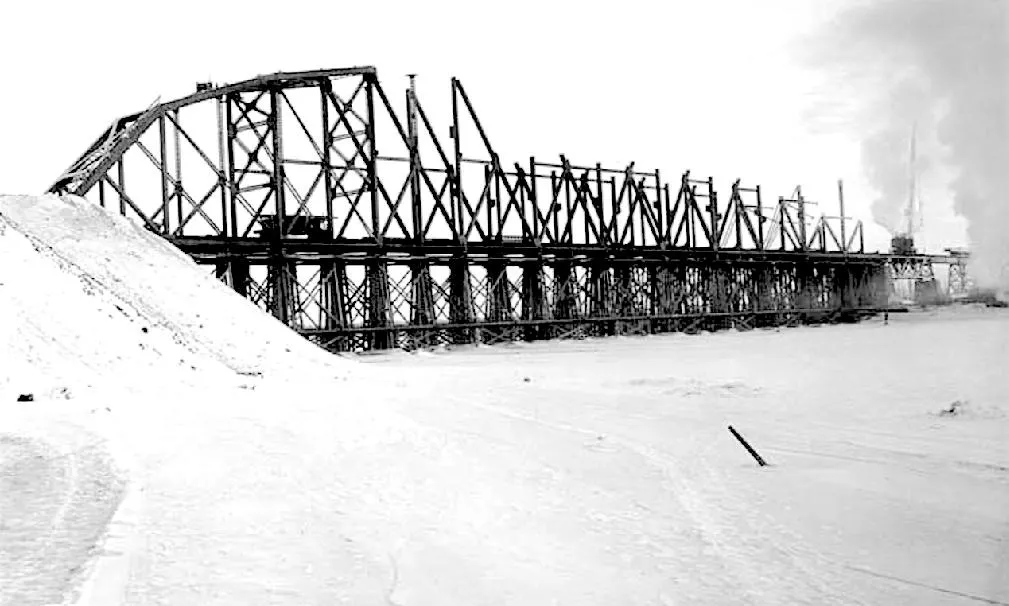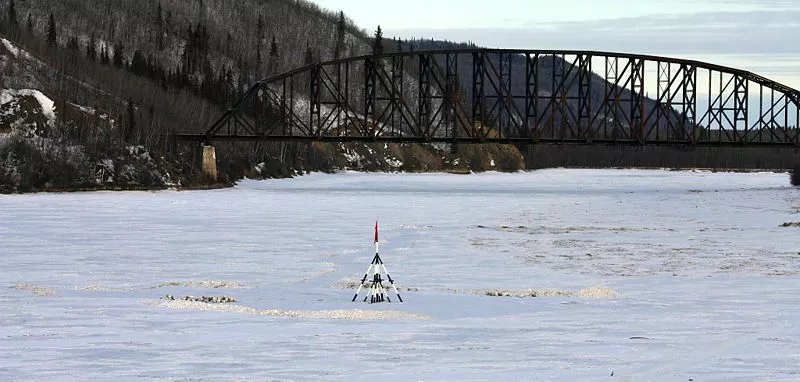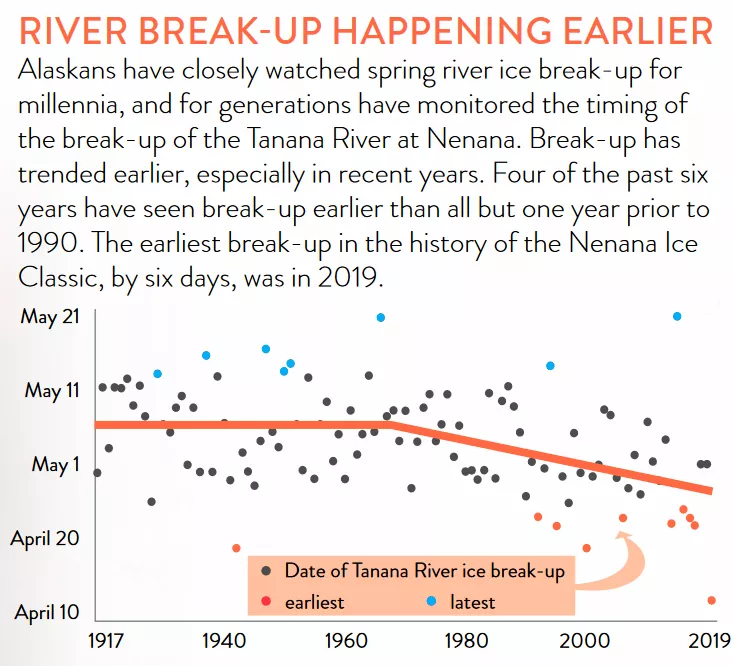By Michon Scott
Nenana is a small Alaskan town that lies along the Tanana River, roughly 75 kilometers (50 miles) southwest of Fairbanks. Ice forms over the Tanana River every autumn, sometimes thickening to a meter (3 feet) through the winter. But sooner or later, spring warmth melts the ice. Predicting precisely how soon or late the ice melts at Nenana has become a heated competition.
A century of competition
The competition started in 1906 as a casual bet between friends on who among them could best predict the ice’s breakup, a bet made when the town held a scant 50 or 60 residents. The contest became an annual event in 1917, after railroad labor swelled the town’s population to roughly 1,000 people.
Railroad workers vied for the $800 jackpot—equivalent to more than $18,000 today—but the timing of the ice’s annual breakup had higher stakes than who won the annual contest. The ice literally supported completion of the Alaska Railroad in 1923. The bridge across the Tanana River at Nenana was one of the final stretches of rail needed to connect Seward and Fairbanks. As workers built the bridge, scaffolding briefly rested directly on the ice. If the ice gave way before the bridge was finished, it would endanger the workers and the project.
Decades after the railroad was completed, the Nenana Ice Classic competition continued, taking bets from outside Nenana and eventually outside Alaska. As the size of the contest grew, organizers refined their procedures. Organizers now deliver or mail entry ticket receptacle cans to businesses across the state to collect bets, while staff in the Nenana Ice Classic office take calls from contestants outside Alaska, who must mail checks to buy their tickets. Once the guessing deadline passes, organizers gather and sort the tickets, an effort employing roughly 100 people—a quarter of Nenana’s current population. Although contest participation dwindled during the COVID-19 pandemic, it quickly rebounded. Identifying the winner now takes several weeks, often continuing well after the ice breaks.
Nowadays, the size of the annual jackpot varies, and the winnings are often split between multiple contestants. Still, anyone guessing the right date and time (to the nearest minute) of the breakup can expect to collect more than $800. Charities also receive proceeds from bets placed.
We have a data set for that
In early 2023, searches related to the Nenana Ice Classic figured among the top 100 search phrases used to reach the NSIDC website, and for good reason. NSIDC provides the Nenana Ice Classic: Tanana River Ice Annual Breakup Dates data set. (Downloading the data set requires a free NASA Earthdata login.)
The data set is a simple comma-separated list enumerating the date and time of the ice breakup each year, from 1917 through 2021. The data set also includes the decimal day of the year: a date expressed purely as a number. For example, the ice melt in 1940 occurred at 3:27 p.m. on April 20. It was the 111th day of the year, a leap year, when the day was nearly 65 percent over, rendering a decimal day of 111.6438.
Decimal days are especially useful to compare breakup dates and times between years.
Is the breakup timing changing?
Comparing the decimal days to each other across the life of the data set suggests a trend toward earlier breakup dates, but the trend is very slight, and the data record is noisy.
In 2019, the University of Alaska Fairbanks’ International Arctic Research Center released a report examining the effects of climate change across Alaska. Rather than making a single trend line for the entire Nenana Ice Classic breakup-date record, the study made two trend lines: one for the earlier part of the data record, the other for the later part. This approach indicated a sharper trend later in the series.
Keep in mind that the Alaska’s Changing Environment report time series ended in 2019, which had a record-early breakup date. The NSIDC data set shows that breakup dates in 2020 and 2021 were closer to the long-term trend line for the time series, from 1917 through 2021.
NSIDC’s Nenana Ice Classic: Tanana River Ice Annual Breakup Dates data set can provide historical context for anyone looking to predict the current year’s breakup. Even so, the breakup dates vary considerably from year to year, and can be affected by short-term local weather conditions. So, maybe you should not bet all your expendable income on this competition.
Access data through the NSIDC DAAC
NASA’s NSIDC DAAC manages, distributes, and supports a variety of cryospheric and climate-related datasets as one of the discipline-specific Earth Science Data and Information System (ESDIS) data centers within NASA’s Earth Science Data Systems (ESDS) Program. User Resources include data documentation, help articles, data tools, training, and on-demand user support. Learn more about NSIDC DAAC services.
NASA NSIDC DAAC data highlighted in this article include:
Nenana Ice Classic. (2020). Nenana Ice Classic: Tanana River Ice Annual Breakup Dates. (NSIDC-0064, Version 2). Meier, W. N. & Dewes, C. F. (Eds.) [Data Set]. Boulder, Colorado USA. NASA National Snow and Ice Data Center Distributed Active Archive Center. https://doi.org/10.5067/CAQ58H42LQY2. [describe subset used if applicable]. Date Accessed 03-27-2025.
References
Donaghue, E. 2023. The River That’s Kept Alaska Guessing for More Than a Century. Smithsonian Magazine.
Hegener, H. 2018. The Alaska Railroad 1902-1923. Excerpt provided by Alaskan History Magazine.
Nenana Ice Classic. Edited by W.N. Meier and C.F. Dewes. 2020. Nenana Ice Classic: Tanana River Ice Annual Breakup Dates, Version 2 [Data Set]. Boulder, Colorado USA. NASA National Snow and Ice Data Center Distributed Active Archive Center. https://doi.org/10.5067/CAQ58H42LQY2. Accessed Apr-07-2023.
Thomas, R., and J.E. Walsh. 2019. Alaska’s changing environment: documenting Alaska’s physical and biological changes through observations. H.R. McFarland, Ed. International Arctic Research Center, University of Alaska Fairbanks.




